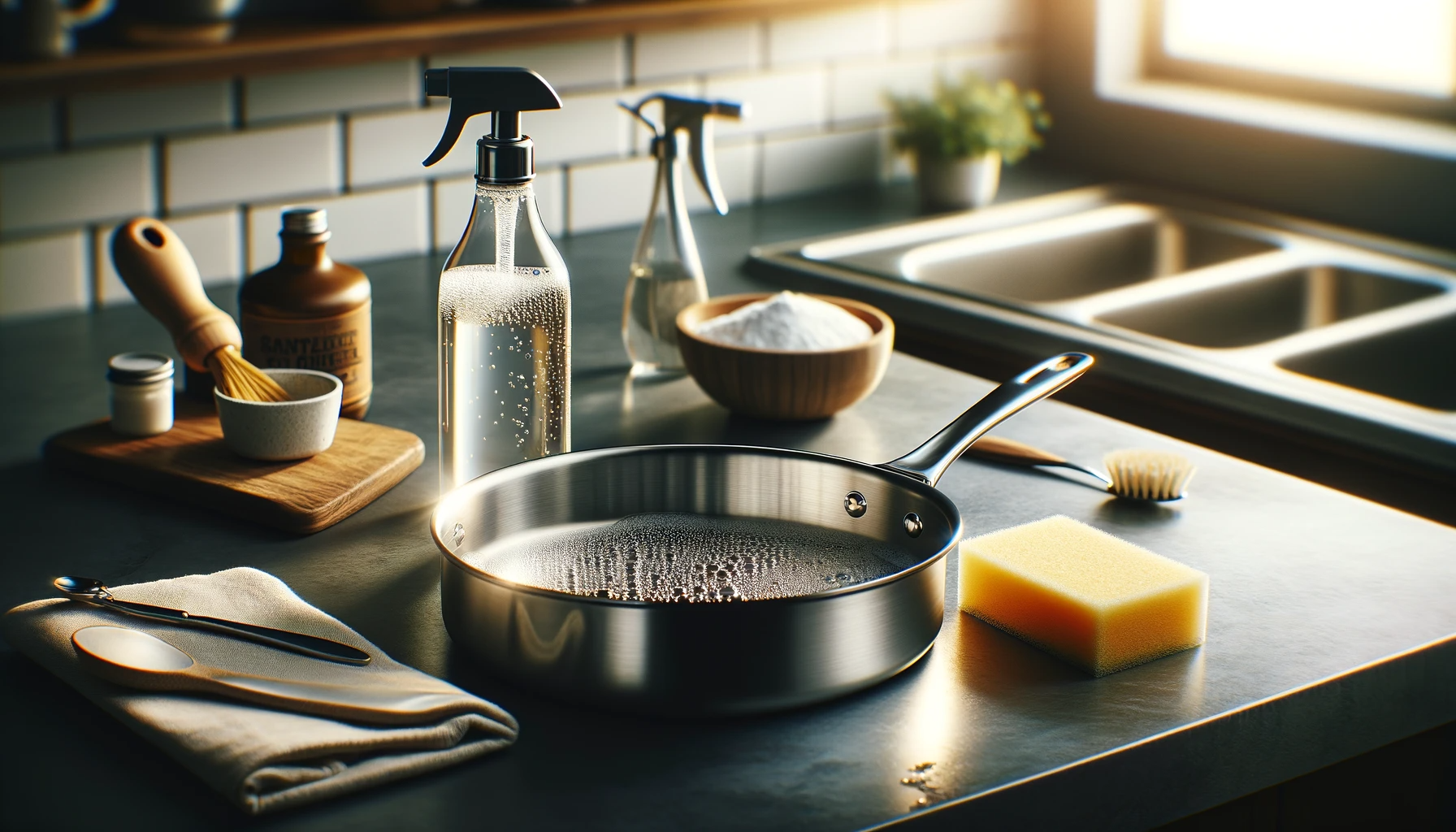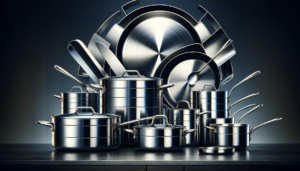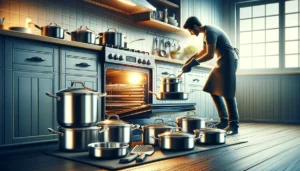Do you dread facing crusty pots and pans with baked on residue?
All-Clad stainless steel cookware allows even the messiest home cooks to produce incredible meals.
But without the right cleaning methods, these performance pans lose their brilliance surprisingly fast.
Luckily a few pantry staples lift the toughest messes while simple preventative care resists new scratches.
Let’s dive into keeping All-Clad cookware gleaming like day one through strategic cleaning.
How to Clean All-Clad Stainless Steel Cookware
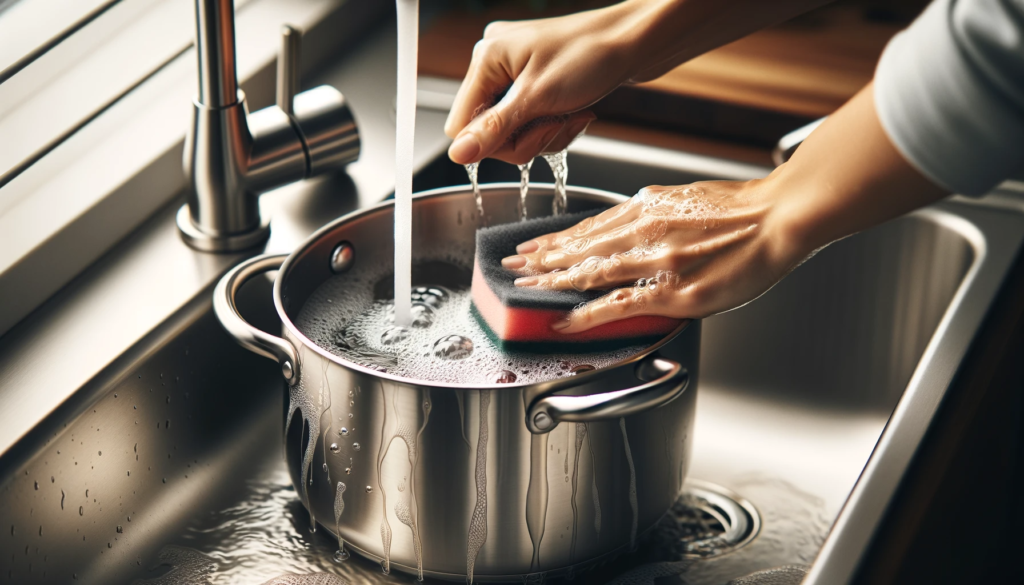
To clean All-Clad stainless steel pots and pans, use a soft sponge or cloth with a couple drops of dish soap and warm water.
Gently scrub the interior and exterior surfaces using light circular motions.
Take care not to use abrasive scouring pads or steel wool that could scratch the finish.
Rinse cookware thoroughly before immediately drying with a soft towel.
For stuck-on residue, make a paste with baking soda and water.
Apply to stubborn areas and let sit before scrubbing again gently.
Avoid abrasives that could damage the brushed cooking surface.
Supplies Needed
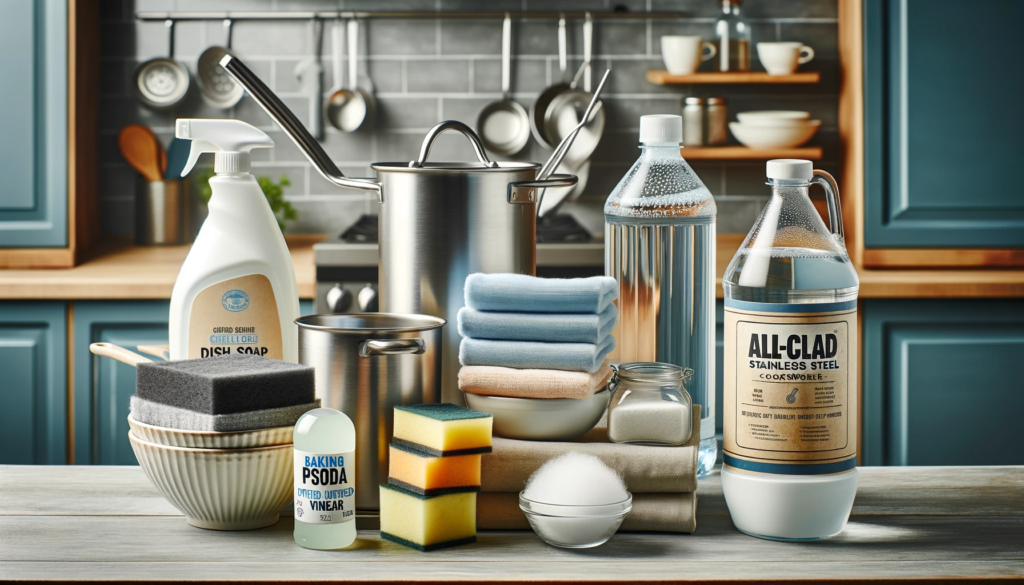
Keeping All-Clad stainless steel pans, pots, and skillets sparkling clean requires having the proper supplies readily available before you begin any cleaning task.
At a minimum, you will need a bottle of gentle dish soap or detergent, soft sponges and cleaning cloths, baking soda, distilled white vinegar, and clean water.
Avoid abrasive scrubbers like steel wool or scouring pads, as these can scratch and damage polished cooking surfaces causing them to lose their shine over time with repeated use.
For dish soap, select plant-based formulations that rinse cleanly without residue.
Standard blue Dawn dish liquid works perfectly for cutting through grease while remaining gentle enough for stainless steel.
Opt for soft cellulose sponges without abrasive scouring sides or microfiber cloths that safely lift grime without risk of scratching.
Have plenty on hand so you always have a fresh one ready.
Harsh scrubbers should be avoided entirely when it comes to keeping All-Clad unscathed.
Baking soda is a natural degreasing agent that lifts burned or baked-on food residue through chemical processes without damaging delicate finishes.
The fine powder is mildly abrasive, yet safe enough for stainless steel unlike other harsh scouring powders.
Plain distilled white vinegar tackles water spots and discoloration due to its acidic properties which dissolve mineral deposits left behind from frequent washing.
Whether used separately or combined, a box of baking soda and gallon jug of vinegar will be your go-to cleaners for tackling all types of grimy cookware messes.
Keep them close by under the kitchen sink.
Of course water is necessary for loosening debris from pan surfaces and rinsing thoroughly after washing.
Make sure to use clean, fresh water each time and avoid letting soapy pans soak for extended stretches.
Thorough rising prevents residue build up over time.
Having these basic cleaning items at the ready will keep All-Clad stainless steel looking impeccable after even the messiest cooking endeavors.
Daily Cleaning
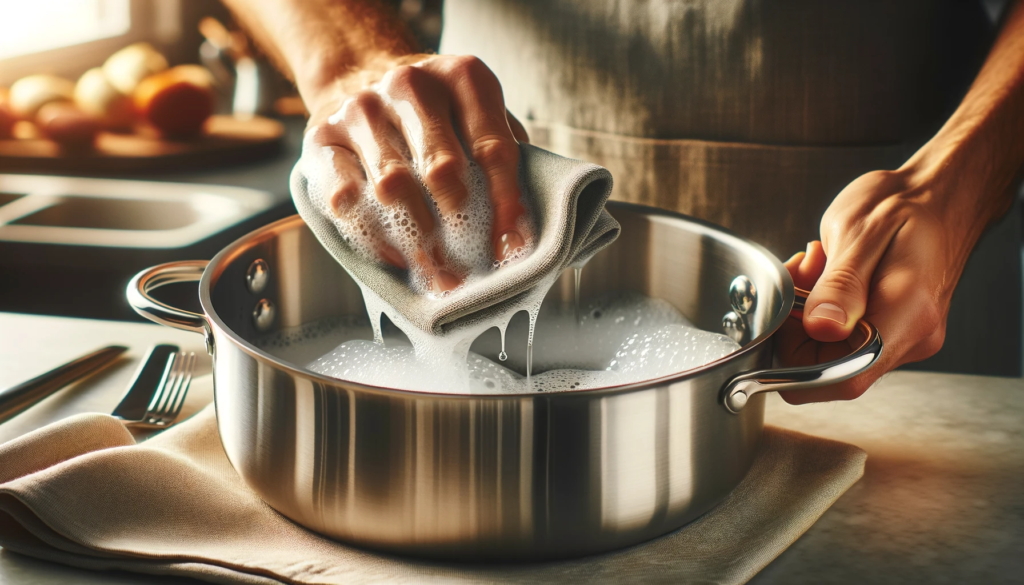
Preventing stuck-on debris in All-Clad stainless steel cookware starts with cleaning thoroughly after each and every use.
Food residue left to sit for hours or days bakes onto pan surfaces, making scrubbing much more difficult later on.
Washing promptly after cooking while foods are still fresh makes removing debris far simpler in the long run.
Get into the habit of filling cookware with warm water and adding a small dollop of dish soap right after eating dinner.
Swish the sudsy water over the interior cooking surface using a soft microfiber cloth or gentle cellulose sponge.
Take care to only apply light pressure, rubbing in small circular motions to lift residue without risk of scratching.
The matte brushed finish of All-Clad stainless steel pans can lose its luster quickly through repeated abrasive scrubbing over time.
Stuck-on starches or greasy drips should dissolve easily with gentle motions using minimal elbow grease.
Be sure to get into corners, around rivets, and underneath handles reaching any greasy fingerprints or splashback.
Empty out dirty wash water promptly once debris lifts rather than letting pots languor filled with grimy bubbles.
Leftover food particles can settle back onto pan surfaces if left too long.
Rinse all soap residue thoroughly under warm running water before drying immediately with a soft towel.
Water droplets lead to mineral stain buildup over time if left to air dry.
Daily cleaning is essential to keep All-Clad stainless steel cookware looking like new for many years.
Stubborn Residue and Stuck-On Food
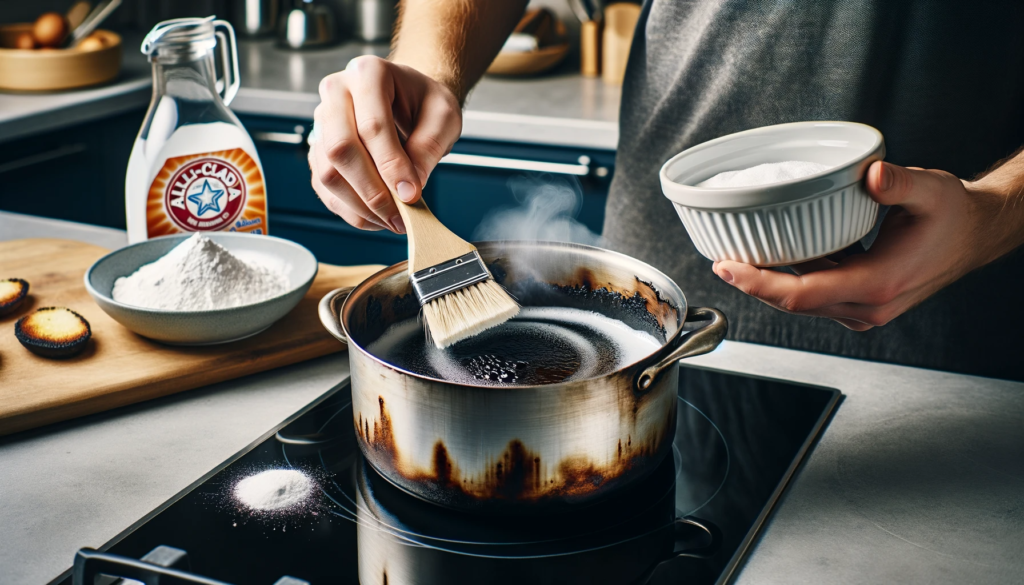
Despite even the most diligent cleaning attempts, sometimes leftover food gets burnt on or otherwise cooked onto the interior of All-Clad stainless pans.
Maybe Monday’s marinara splattered and then baked onto the walls of your skillet.
Or Thursday’s lemon chicken left sticker, sugary drips that transformed into carbonized glue.
Tough cleaning conundrums happen occasionally despite our best intentions to stay on top of cookware maintenance.
Luckily heavy-duty artillery in the form of plain old baking soda can loosen even the toughest of stuck-on messes.
Thanks to mildly abrasive texture blended with natural degreasing capabilities, a baking soda paste transforms into an easy, non-toxic cleaner that rivals harsh chemical solvents without added risks of damaging delicate surfaces.
Mix baking soda with enough warm water to form a thick, spreadable paste about the texture of toothpaste.
Apply the paste generously on top of burnt spots or residue with an old toothbrush, soft sponge, or microfiber cloth.
Let the paste rest for at least ten minutes, allowing baking soda’s chemical properties time to penetrate and bubble away at the stuck-on grime.
You can apply heat during this step to intensify cleaning power by placing pan over low burner for a minute or microwaving paste-filled pots for thirty seconds.
Just don’t let mixture dry out completely.
As it sets, baking soda lifts stains similar to commercial oven cleaners but without caustic smells or risky fumes.
After letting paste soak in for a bit, scrub gently with a soft brush or sponge, rinsing well to remove all traces of debris.
Repeat process as needed for extra stubborn spots.
While baking soda works wonders, take care to discard abrasive scouring pads or steel wool that can scratch and damage All-Clad’s delicate brushed finish.
A little extra elbow grease is better for cookware longevity than quick fixes involving anything too harsh.
With the right gentle cleaning paste, soaking time, and soft tools, even the most seemingly unsalvageable mess lifts free from stainless steel restoring pans to a like-new condition.
Discoloration and Minor Scratches
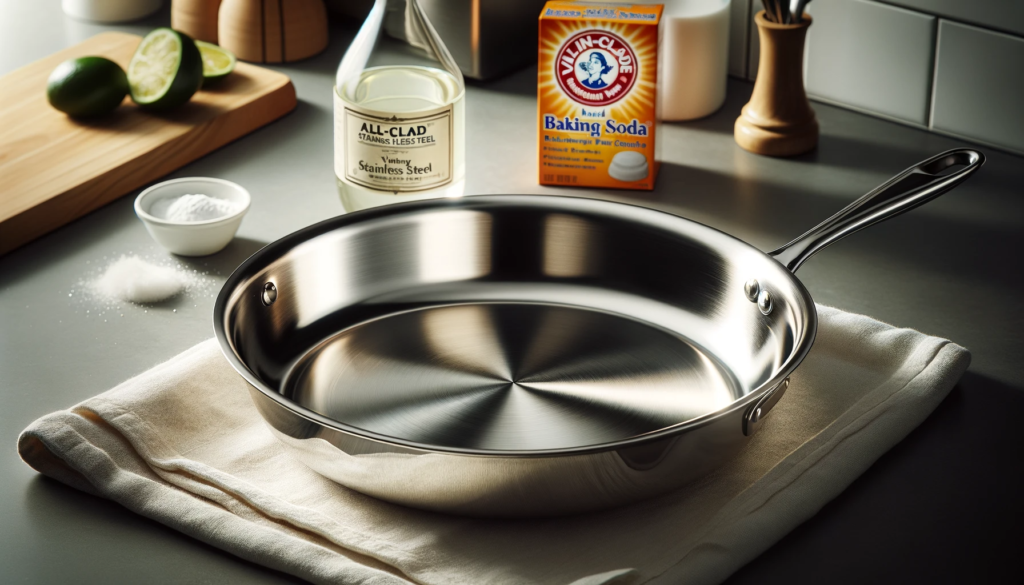
Though renowned for durability, All-Clad stainless steel pans can develop discoloration over time in the form of rainbow-hued mineral staining or heat tint bands around the sides.
Even quality cookware eventually shows sign of heavy use through scratched surfaces or lost shine.
Luckily restoring stain-free brilliance is simple without drastic measures.
another common kitchen pantry staple – distilled white vinegar – works wonders dissolving ugly mineral buildup or surface stains when combined with baking soda into an activated foaming paste.
For heat-related discoloration or minor scratches, just mix one part baking soda with one part undiluted vinegar until a fizzing paste forms.
Gently rub the mixture onto affected areas using soft cloth or cellulose sponge then let bubble for 5 to 10 minutes allowing vinegar to react.
The acid in vinegar dissolves deposits while soda lifts stains for a gentle yet effective one-two punch.
After letting paste do its work, rinse cookware thoroughly before drying by hand.
Avoid abrasives that could worsen scratches.
For shine restoration, occasionally treat All-Clad stainless steel to a deeper cleaning polish by massaging a dab of food-grade mineral oil vigorously over surfaces with soft cloth.
Allow to set a few minutes then wipe away excess oil pooling.
The treatment seals minor scratches, nourishes metal, and adds brilliant luster better than dish soap alone.
With a little knowledge of pantry cleaner secrets, drab and dull cookware transform back to gleaming life without heavy chemicals or special equipment.
Prevention of Scratches and Stains
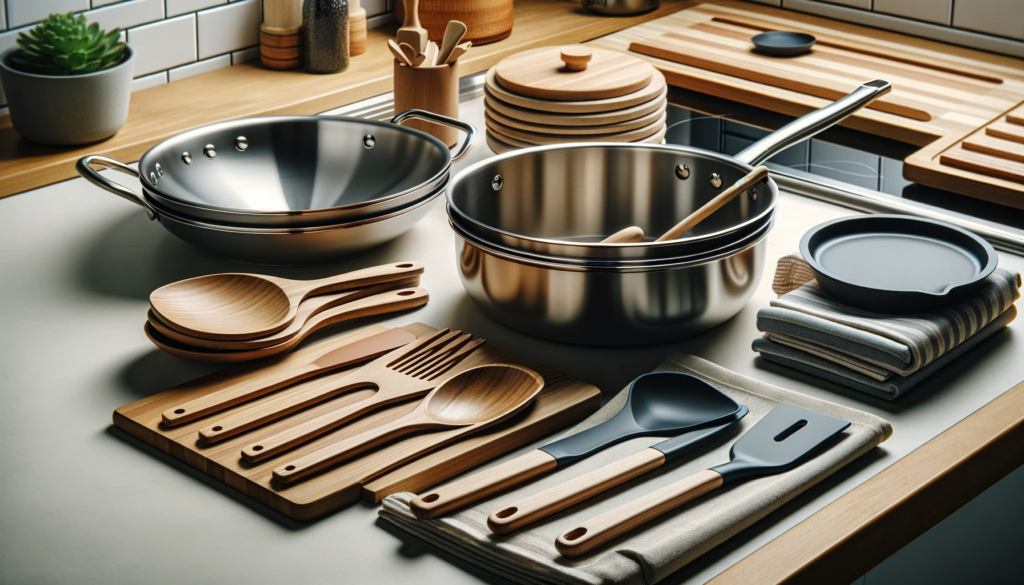
Diligent care is essential for keeping All-Clad stainless steel cookware looking pristine after years of reliable service.
While extremely durable under normal usage, a few preventative steps help these performance pans withstand demanding daily duty resisting scratches and stains over time.
From smart stacking strategies to using appropriate cooking utensils, mindful maintenance makes avoiding damage easier.
Always choose soft materials like wood, plastic, or heat-safe silicone when mixing or serving foods to minimize scratches during cooking.
Metal spatulas, steel wool, and sharp forks scrape away at polished cooking surfaces causing shiny finishes to become marred and dull surprisingly fast.
Non stick and enamel coatings help protect some pans but stainless steel remains vulnerable.
Likewise avoid cutting foods directly in pans which can gouge delicate brushed metal.
Another preventative measure includes washing cookware immediately after eating dinner rather than leaving leftovers stuck overnight where grime dries into a stubborn cement-like mess.
Quick soaking in warm soapy water prevents debris from hardening into something requiring heavy-duty abrasives down the line just to lift – which ultimately damage pan finishes.
Light cleaning while foods remain somewhat fresh eliminates need for repeat scrubbing later.
When storing cookware, pay special attention to stacking by keeping similar metals together and cushioning between hard materials like stoneware or cast iron.
Place folded kitchen towels or silicone trivets between items to prevent surfaces from grinding together during opening and closing cabinets.
Weight and pressure causes small dents and scratches to accumulate slowly over time.
A little padding protects stainless steel meaning your favorite skillet stays shiny season after season.
Conclusion
Caring for All-Clad stainless steel cookware properly helps these high-quality pans last for years.
With the right gentle cleaning methods and preventative care, you can keep your investment sparkling like new.
Follow these cleaning tips to lift stubborn residue, remove stains, and prevent future scratches or damage.
Treating All-Clad pans with care leads to a lifetime of reliable cooking performance.
